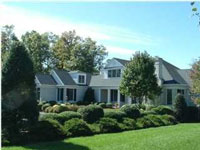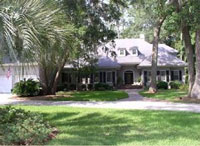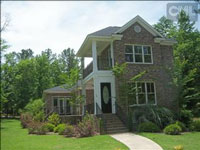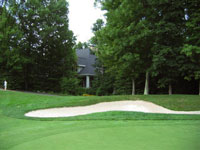|
Reader Feedback
We want to make this newsletter as useful as possible for you. If you have comments, critiques, suggestions or observations about the newsletter, please email them to me at This email address is being protected from spambots. You need JavaScript enabled to view it.. I promise to respond quickly.
Homes of the Month
August 2009
Each month, I will post a few homes that are currently on the market in golf communities I have visited and recommend. I have excellent contacts in each community and can help arrange visits for interested parties. There is never a charge for my services. For more information about any of these homes or any other golf communities in the southern U.S., contact me at This email address is being protected from spambots. You need JavaScript enabled to view it. and I will get back to you promptly.

Glenmore
Keswick, VA (15 minutes from Charlottesville)
5 BR, 3 BA + two half BA,
4,587 sq. ft
Basement billiard room, office/studio above detached garage...$879,000

The Landings at Skidaway Island
Savannah, GA
3 BRs, 4 ½ BAs, 4.665 sq. ft.
Bonus rm. incl. wet bar and full BA
Six private golf courses on property...$699,000

Cobblestone Park
Blythewood, SC
3 BR, 2 ½ BA, 2,513 sq. ft.
Charleston style brick home, downstairs master, granite kitchen counters...$385,000
(See accompanying article)

Champion Hills
Hendersonville, NC
4 BRs, 4 BAs, two half BAs,
7,740 sq. ft.
3 acres, estate home with view of classic Fazio golf course
$1.24 million (for sale by bank; assessed at $2.1M)
|
Living with the relatives when searching for a golf course home
You don’t have to be an Einstein to understand the theory of relativity as it applies to costing out your future home in a golf community. Everything is relative, and no one cost factor alone matters too much.
At discussion boards like City-Data.com, the most frequently asked question from those contemplating an interstate move seems to be, “How much can I expect to pay in taxes?” Or what are the homeowner association dues in a community in, say, Savannah compared with one in, say, Asheville? Other folks obsess about taxes on property like cars and boats. In isolation, worries like these are irrelevant. The real question should be about total cost of living, not the components, and which particular area or community best matches your lifestyle.
Marketing disinformation
Marketing, of course, exacerbates the misconceptions. Communities in Florida and Tennessee, for example, ignore any references to overall cost of living and, instead, market the lack of a state income tax. That certainly may be attractive to a retiree with a pension and stock dividends in the millions, but Joe Bag of Donuts from Kankakee (and most of the rest of us) should not care less about the state tax rate if his pension and Social Security payments are modest. Property and sales taxes together can take a bigger bite than a 6% state income tax.
The theory of relativity extends to the communities themselves. Sometimes their prices are too good to be true, and of course there is a reason. Wonderful communities like Haig Point on Daufuskie Island near Hilton Head tout free golf membership and incredibly low-priced properties for the amenities they offer. In Haig Point’s case, it’s a splendid Rees Jones 29-hole golf course (that’s not a typo, it really does have 29 holes) and a relaxing overall ambience that can breathe new life into the most stressed-out body. Although pure island living (no cars allowed on Daufuskie) is not for everyone, those who want to get away from air and noise pollution will find no better place.
Free can be expensive
So what’s the catch when you receive a gratis $65,000 golf membership at Haig Point and can buy an attractive 3,000 square foot house for under $500,000? Well, that ferry that brings you back and forth from Hilton Head is expensive to maintain, and the yin of no initiation fee is compensated by the yang of an ultra-high dues structure, a total of about $20,000 per year for the club and homeowners’ fees. And should you want to build on that bargain basement lot you bought, count on up to $500 per square foot in construction costs because everything –- materials and labor -– must be shipped in. Haig Point is a great place, but cheap overall it is not.
Such faux bargains are touted elsewhere, and at even lower prices. In the Myrtle Beach area, for example, some golf communities are so desperate to move their inventory of lots and $200,000 homes that they have offered free golf membership and a waiver of dues for a couple of years. Move there, however, and you find that you are sharing your public golf course with so many others that you have to arrange your life around arranging tee times. At that point, that bargain turns costly in terms of lifestyle.
We are currently in a strong buyer’s market. The greatest risk to a buyer in this market is not overspending; it is hard to do that with the inventory of homes available and the odor of desperation hanging over many sellers. The greatest risk is to chase the biggest savings at the expense of ultimate happiness.
Chaos theory: Golf communities with tumultuous pasts can be bargains
You can count on a few unassailable truths in real estate. Most basic of all is that when demand is high and supply low, then prices are high. That, of course, was the case prior to 2006. But when demand is low and supply high, then prices are low, which of course is the market we face now.
The other truth about real estate, as with any “investment,” is that your upside potential for appreciation is directly related to the risk you are willing to take. That is why some bonds, for example, can pay such impressive dividends. But they don’t call them “junk” for nothing. Investing in real estate –- as a homeowner or a speculator –- carries similar risks and rewards.
Discounts up to 50% or more
In the current golf community market, you can purchase a home or property at a nice discount to its value of just two years ago. In a fully mature community, for example, where the clubhouse, pool, tennis courts and fitness center, as well as the golf course, are fully operational, I’d estimate prices are generally 20% to 30% of where they were a couple of years ago. But in some communities that were teetering on the brink before some bank stepped in with rescue financing, or its residents pitched in to assess themselves a little more in order to avoid losing a lot when the developer defaulted, the discounts are substantial, as much as 50% or more compared with original pricing (this would seem to cover virtually all of Las Vegas and Phoenix, for example).
In such situations, however, the originally promised amenities have not been built, and they may not be for some years. That is a risk any purchaser takes, and developers know it. In some communities, therefore, even in some nice ones, the developers have priced their remaining properties so low that their existing residents are up in arms. And well they should be since a property just like the one for which they paid $300,000 three years ago is now on the market for $100,000.
Once a Ginn, now maybe a bargain
That is the case at Cobblestone Park, a former Ginn Resorts property near Columbia, SC, one of a number of properties Ginn had to shed in the wake of its huge loan default to Credit Suisse. The clubhouse there is half built, the golf club has gone from private to public, a potential new owner is still considering his prospects, and the residents are angry over their significant loss of value. But from my recent visit, Cobblestone Park appears to have “good bones” and I saw no outward signs of the community’s troubles. With an organized plan and additional investments, new ownership could help turn a $75,000 investment in a lot there today into a much more valuable piece of dirt a year or two from now.
If you are considering buying property or a home in a community with a troubled past and anything but a rock-solid future, proceed with extreme caution. Visit, ask a lot of questions inside and outside the community, and believe about half of what you hear, if that. Unless you have a great tolerance for risk, the advice here is to buy your home or property in an established community where every amenity is in place and where the developer has turned the property over to the owners (except, perhaps, the golf club). The higher price you pay will carry a built-in premium for the security of your investment.
Market status, from the horses’ mouths
Comments on market conditions from realtors I know and trust.
“I have just done contracts on two homes and have gotten one set of signatures on a third. This could be a good month.” — Jerry Biffle, Plantation Properties, Southport, NC
“Definitely a buyer's market here with home prices about 20% to 25% below the market high of several years ago. It now appears that the pricing has bottomed out, and I expect that after Labor Day, new listings will start to inch up in asking price. — Mike Burch, The Landings at Skidaway Island, Savannah, GA
“…we have had a very, very busy summer. Our listings have doubled in the last 6-9 months, and we have been very busy working with out of town buyers… we have seen a real up tick in people getting back into the vacation home market.” — Carol Clay, Keller Williams, Brevard, NC
If you would like to talk with any of these or other well qualified real estate agents I know personally, please contact me at This email address is being protected from spambots. You need JavaScript enabled to view it. and I will be pleased to put you in touch with them.
|